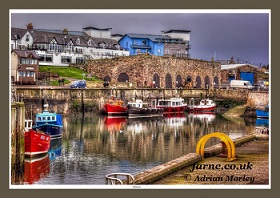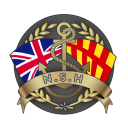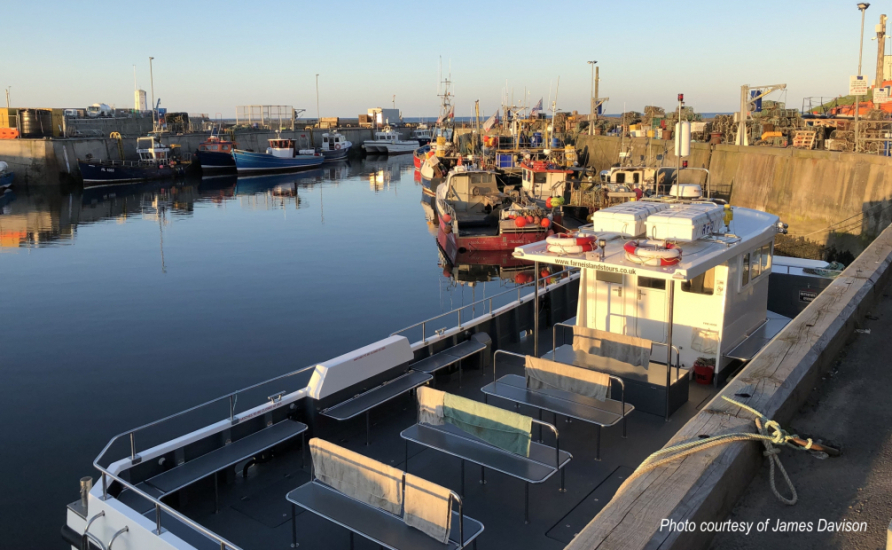North Sunderland and Seahouses lie just 3 miles south of Bamburgh, with North Sunderland being the older, original village. Sunderland literally means, 'Southern land' and refers to it placement to Bamburgh. The word North was added later to avoid confusion with Sunderland in Wearside.
In the dark ages, North Sunderland was established away from the sea as a protection measure; it gave the village a chance to prepare for any potential attack from the Norsemen & Vikings. The sea would have been worked, and any suspicious sighting quickly reported to the villagers using runners.
Remains of a Neolithic cup and ring marked stone were found near a Bronze Age burial at Seahouses and another Bronze Age burial site was found in a cyst at North Sunderland. In the early medieval times the Farne islands were used by Christians to seek solitude and amongst a succession of others was St Cuthbert. St Cuthbert dominates historical records of the medieval parish. A small Benedictine cell developed on Inner Farne around the two chapels of St Mary and St Cuthbert.
Heavily reliant on getting victuals from the mainland, the monks did cultivate part of the Inner Farne and traces of ridge and furrow ploughing can still be seen today. On the mainland, places like 'Monkshouse' were used to support the monks on the islands. At the time, people lived mainly in North Sunderland and old Shoreston and used ridge and furrow to farm the surrounding land; traces of this are still evident behind the dunes at St Aidans.
In the 18th Century fishing took off in an amazing way in the area, and the harbour become more and more popular, resulting in North Sunderland's 'Sea Houses' growing rapidly. North Sunderland village was quickly taken over by the new village and although classed as two separate places, its hard to know where one village starts and the other ends.
Locally both together are known as 'the village'; and despite its growing size and hugely migrant occupants it has managed to keep the special small community spirit of old.
.JPG)
The harbour began life as a small wooden jetty between two natural rock promontories. The first 'modern' jetty or pier was built by the Lord Crewe trustees, and the first phase of construction began in 1786.
It was an important task, as during the early to mid 1700's, both the fishing and lime trades began to thrive. As well as this, the export of coal and quarry stone from the harbour ensured it's growth. The four lime-kilns, which are still visible were built to support the trades.

Although the coal and lime industries began to decline during the 19th century, the harbour usage reached it's peak, with an abundance of fishing vessels, colliers and other vessels utilising the main piers. In fact, during the early 1800's Alexander Ewing aquired some land near the harbour for the processing of herring, building herring yards and smokehouses, and by 1855, six of these yards were in existence.

At least 50 herring boats, as well as other traditonal fishing vessels operated from North Sunderland, and combined with the growing marked for fish and curing, the harbour remained successful enough to warrant further expansion. A second phase of construction began in 1886, and lasted for 3 years, resulting in the basic layout still seen today.

What the harbour could have looked like!
During its life, the harbour had always accomodated the passenger trade, and it was this that caused the eastern pier to be extended in 1933. The passenger trade would continue to grow steadily until the present day, and a 'hammer head' was added to the North Pier.
Over the years the call for the local fishing industries decreased compounded by the closure of the North Sunderland Railway in the 1950's. By the 1980's the harbour was homing around 30 fishing boats. Comparatively recently the tradional industries have been overtaken by the leisure and tourism industry, with the majority of boats still remaining catering for this; although of course some fishing boats remain.

The harbour maintenance remains constant, with a wall built under Crewe Street in 1988 to help combat erosion, a concrete casing was added to the inner harbour in 1991, and emergency repairs were made in 2000. The same year saw the slipway extended, the cost of both totalling £160,000.
Dredging of the harbour occurs every two to three years to remove the silt and sediment that continually builds up, and North Sunderland Harbour Commissioners are constantly striving to improve the Harbour and its facilities.
Over the past 10 years much work has been carried out to achieve this including:
- New build stores and containers for fishermen and commercial leisure operators use.
- Re surfacing of almost all piers and areas open to the public with Tarmac.
- Two bait freezer stores for the inshore fishermen.
- Vastly improved Harbour lighting and marina style bollards on the piers to deliver electricity and water in a safe and efficient manner.
- Rock revetment placed at the head of the outer Harbour to diffuse backwash from incoming swells making safer overnight berths for local and visiting vessels alike.
- Reinforcement & rebuilding of main pier areas.


